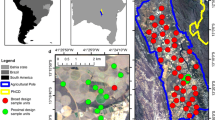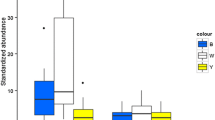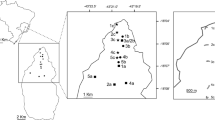Abstract
The decline of Aculeata has raised concerns regarding their conservation and the maintenance of their function as important pollinators. Pan trapping is among the most frequently used methods for monitoring these organisms. Numerous researchers have suggested using pan traps of multiple colors in addition to the yellow traps. Here we provide the first data for the color preferences of European Aculeata by analyzing 5,421 individuals from 356 species of bees and wasps obtained using white, yellow, turquoise and pink pan traps. The total capture rates and diversity were higher in the white and yellow traps over the turquoise and pink ones. The species-specific abundance did not follow changes in the total capture rates. Nevertheless, only seven (of the 96 most commonly captured species) were captured at low rates in the yellow traps, but were obtained at high rates in the white traps. Only two species (Apis mellifera and Priocnemis minuta) were captured preferentially to other than white or yellow traps. Importantly, caution is needed when assessing the sex ratios of Aculeata obtained by pan trapping because many Aculeata display sex-specific color preferences. For example, in Dasypoda hirtipes, we captured 14 of 16 males in the yellow traps, but obtained 34 of 38 females in the turquoise traps. We provide experimental evidence that the females of numerous oligolectic bees (collecting pollen for their brood on a few specific plant species) display more stringent trap color preferences than their males, which correlates with their observed flower color preferences.






Similar content being viewed by others
References
Abrahamczyk S, Steudel B, Kessler M (2010) Sampling Hymenoptera along a precipitation gradient in tropical forests: the effectiveness of different coloured pan traps. Entomol Exp Appl 137:262–268
Barker AM, Sanbrooke KJ, Aebischer NJ (1997) The water trap colour preferences of farmland sawflies. Entomol Exp Appl 85:83–86
Bashir MA, Saeed S, Sajjad A (2013) Monitoring Hymenoptera and Diptera pollinators in a subtropical forest of Southern Punjab, Pakistan. Pak J Agric Sci 50:359–366
Biesmeijer JC, Roberts SPM, Reemer M, Ohlemüller R, Edwards M, Peeters T, Schaffers AP, Potts SG, Kleukers R, Thomas CD, Settele J, Kunin WE (2006) Parallel declines in pollinators and insect-pollinated plants in Britain and the Netherlands. Science 313:351–354
Bogusch P, Blažej L, Trýzna M, Heneberg P (2014) Forgotten role of fires in Central European forests: critical importance of early post-fire successional stages for bees and wasps (Hymenoptera: Aculeata). Eur J Forest Res. doi:10.1007/s10342-014-0840-4
Burkle LA, Marlin JC, Knight TM (2013) Plant-pollinator interactions over 120 years: loss of species, co-occurrence, and function. Science 339:1611–1615
Campbell JW, Hanula JL (2007) Efficiency of Malaise traps and colored pan traps for collecting flower visiting insects from three forested ecosystems. J Insect Conserv 11:399–408
Cane JH, Minclkey RL, Kervin LJ (2000) Sampling bees (Hymenoptera: Apiformes) for pollinator community studies: pitfalls of pan-trapping. J Kans Entomol Soc 73:225–231
Clare G, Suchling DM, Bradley SJ, Walker JTS, Shaw PW, Daly JM, McLaren GF, Wearing CH (2000) Pheromone trap colour determines catch of non-terget insects. N Zeal Plant Prot 53:216–220
Colwell RK, Coddington JA (1994) Estimating terrestrial biodiversity through extrapolation. Philos Trans R Soc Lond Ser B 345:101–118
Dirrigl FJ (2012) Effectiveness of pan trapping as a rapid bioinventory method of freshwater shoreline insects of subtropical Texas. Southwest Entomol 37:133–139
Disney RHL, Erzinçlioglu YZ, Henshaw DDC, Howse D, Unwin DM, Withers P, Woods A (1982) Collecting methods and the adequacy of attempted fauna surveys with reference to the Diptera. Field Stud 5:607–621
Dyer AG, Dorin A, Reinhardt V, Garcia JE, Rosa MGP (2014) Bee reverse-learning behavior and intra-colony differences: simulations based on behavioral experiments reveal benefits of diversity. Ecol Model 277:119–131
Edwards R, Telfer MG (eds) (2001) Provisional atlas of the aculeate Hymenoptera of Britain and Ireland. Part 3. Biological Records Centre, Huntingdon
Faegri K, van der Pijl L (1980) The principles of pollination ecology, 3rd edn. Pergamon Press, Oxford
Farkač J, Král D, Škorpík M (eds) (2005) [Red list of threatened species in the Czech Republic. Invertebrates]. AOPK ČR, Prague (in Czech)
Giurfa M, Nunez J, Chittka L, Menzel R (1995) Colour preferences of flower-naïve honeybees. J Comp Physiol A 177:247–259
Gollan JR, Ashcroft MB, Batley M (2011) Comparison of yellow and white pan traps in surveys of bee fauna in New South Wales, Australia (Hymenoptera: Apoidea: Anthophila). Aust J Entomol 50:174–178
Gumbert A (2000) Color choices by bumble bees (Bombus terrestris): innate preferences and generalization after learning. Behav Ecol Sociobiol 48:36–43
Gumbert A, Kunze J (2001) Colour similarity to rewarding model plants affects pollination in a food deceptive orchid, Orchis boryi. Biol J Linn Soc 72:419–433
Hammer Ø, Harper DAT, Ryan PD (2001) PAST: paleontological statistics software package for education and data analysis. Palaeontol Electron 4:1–9
Hegland SJ (2014) Floral neighbourhood effects on pollination success in red clover are scale-dependent. Funct Ecol 28:561–568
Hempel de Ibarra N, Vorobyev M, Menzel R (2014) Mechanisms, functions and ecology of color vision in the honey bee. J Comp Physiol 200:411–433
Heneberg P, Bogusch P, Astapenková A (2014) Reed galls serve as an underestimated but critically important resource for an assemblage of aculeate hymenopterans. Biol Conserv 172:146–154
Herman TJB, Cameron PJ, Walker GP (1994) Effect of pheromone trap position and colour on tomato fruit worm moths and bumblebees. Proc 47th N Zeal Plant Prot Soc Conf, Wellington, pp 154–158
Keasar T, Motro U, Shmida A (2013) Temporal reward variability promotes sampling of a new flower type by bumblebees. Anim Behav 86:747–753
Kelber A (2001) Receptor based models for spontaneous colour choices in flies and butterflies. Entomol Exp Appl 99:231–244
Kirk WDJ (1984) Ecologically selective coloured traps. Ecol Entomol 9:35–41
Kostal V, Finch S (1996) Preference of the cabbage root fly, Delia radicum (L.) for coloured traps: influence of sex and physiological status of the flies, trap background and experimental design. Physiol Entomol 21:123–130
Krebs CJ (1989) Ecological methodology. Harper and Row, New York
Leong JM, Thorp RW (1999) Colour-coded sampling: the pan trap colour preferences of oligolectic and nonoligolectic bees associated with a vernal pool plant. Ecol Entomol 24:329–335
Lunau K, Maier EJ (1995) Innate colour preferences of flower visitors. J Comp Physiol A 177:1–19
Menzel R (1967) Untersuchungen zum Erlernen von Spektralfarben durch die Honigbienen (Apis mellifica). Z Vgl Physiol 56:22–62
Michener CD (2007) The bees of the world, 2nd edn. Johns Hopkins University Press, Baltimore
Nielsen A, Steffan-Dewenter I, Westphal C, Messinger O, Potts SG, Roberts SPM, Settele J, Szentgyörgyi H, Vaissière BE, Vaitis M, Woyciechowski M, Bazos I, Biesmeijer JC, Bommarco R, Kunin WE, Tscheulin T, Lamborn E, Petanidou T (2011) Assessing bee species richness in two Mediterranean communities: importance of habitat type and sampling techniques. Ecol Res 26:969–983
O’Neill KM (2001) Solitary wasps: behavior and natural history. Comstock Publishing Associates, New York
Peitsch D, Fietz A, Hertel H, de Souza J, Ventura DF, Menzel R (1992) The spectral input systems of hymenopteran insects and their receptor-based colour vision. J Comp Physiol A 170:23–40
Poole RW (1974) An introduction to quantitative ecology. McGraw-Hill, New York
Ramírez-Freire L, Alanís-Flores GJ, Ayala-Barajas R, Quiroz-Martýnez H, Velazco-Macías CG (2012) Las abejas del género Agapostemon (Hymenoptera: Halictidae) del estado de Nuevo León, México. Rev Mex Biodivers 83:63–72
Roulston TH, Goodell K (2011) The role of resources and risks in regulating wild bee populations. Annu Rev Entomol 56:293–312
Saunders ME, Luck GW (2013) Pan trap catches of pollinator insects vary with habitat. Aust J Entomol 52:106–113
Spafford RD, Lortie CJ (2013) Sweeping beauty: is grassland arthropod community composition effectively estimated by sweep netting? Ecol Evol 3:3347–3358
Stephen WP, Rao S (2005) Unscented color traps for non-Apis bees (Hymenoptera: Apiformes). J Kans Entomol Soc 78:373–380
Toler TR, Evans EW, Tepedino VJ (2005) Pan-trapping for bees (Hymenoptera: Apiformes) in Utah’s West Desert: the importance of color diversity. Pan-Pac Entomol 81:103–113
Tropek R, Černá I, Straka J, Čížek O, Konvička M (2013) Is coal combustion the last chance for vanishing insects of inland drift sand dunes in Europe? Biol Cons 162:60–64
Tuell JK, Ascher JS, Isaacs R (2009) Wild bees (Hymenoptera: Apoidea: Anthophila) of the Michigan highbush blueberry agroecosystem. Cons Biol Biodivers 102:275–287
von Frisch K (1971) Bees: their vision, chemical senses, and language. Cornell University Press, Ithaca
Vrdoljak SM, Samways MJ (2012) Optimising coloured pan traps to survey flower visiting insects. J Insect Conserv 16:345–354
Westrich P (1989) Die Wildbienen Baden-Württembergs. Eugen Ulmer Verlag, Stuttgart
Wilson JS, Griswold T, Messinger OJ (2008) Sampling bee communities (Hymenoptera: Apiformes) in a desert landscape: are pan traps sufficient? J Kans Entomol Soc 81:288–300
Acknowledgments
The study was supported by the PRVOUK project P31/2012 from the Charles University in Prague, and by the Specifický výzkum projects 2101/2013 and 2102/2013 from the University of Hradec Králové. We thank Lukáš Nývlt and Pavlína Tauchmanová for their help with field sampling. We thank Pavel Tyrner and Jakub Straka for the revision of several specimens from the Chrysididae and Pompilidae families.
Author information
Authors and Affiliations
Corresponding author
Electronic supplementary material
Below is the link to the electronic supplementary material.
10841_2014_9723_MOESM1_ESM.pdf
Supplementary table 1: List of the species found, including the information on their sex, number captured by traps of each of the colors tested, number of trap-days, country where the species were captured, and their Red List status in the Czech Republic (PDF 131 kb)
10841_2014_9723_MOESM2_ESM.pdf
Supplementary table 2: Observed and expected numbers of individuals captured by traps of each of the colors tested. Shown are the species captured at n ≥ 10 individuals only (n = 96 species), the capture rates were tested by the χ2 tests with Bonferroni correction (PDF 130 kb)
Rights and permissions
About this article
Cite this article
Heneberg, P., Bogusch, P. To enrich or not to enrich? Are there any benefits of using multiple colors of pan traps when sampling aculeate Hymenoptera?. J Insect Conserv 18, 1123–1136 (2014). https://doi.org/10.1007/s10841-014-9723-8
Received:
Accepted:
Published:
Issue Date:
DOI: https://doi.org/10.1007/s10841-014-9723-8




